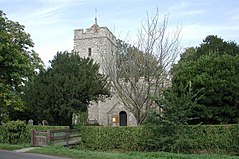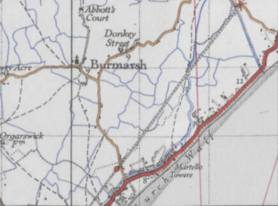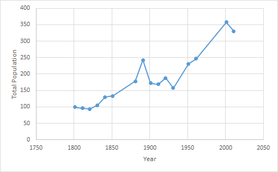Burmarsh: Difference between revisions
No edit summary |
No edit summary |
||
| Line 29: | Line 29: | ||
The meaning of Burmarsh comes from Old English. Bur comes from "Burh-Ware" which equates to "Town Dwellers, and "Mersc" which means "Marsh". Therefore if we collaborate these, Burmarsh means "Marsh of Town Dwellers".<ref>{{Cite web|url=http://www.kentpast.co.uk/burmarsh.html|title=History of Burmarsh|last=|first=|date=|website=Kent Past|archive-url=|archive-date=|dead-url=|access-date=}}</ref> |
The meaning of Burmarsh comes from Old English. Bur comes from "Burh-Ware" which equates to "Town Dwellers, and "Mersc" which means "Marsh". Therefore if we collaborate these, Burmarsh means "Marsh of Town Dwellers".<ref>{{Cite web|url=http://www.kentpast.co.uk/burmarsh.html|title=History of Burmarsh|last=|first=|date=|website=Kent Past|archive-url=|archive-date=|dead-url=|access-date=}}</ref> |
||
Burmarsh appears in the Domesday Book as both Borchemeres and Burwarmaresc. It was one of the very first known settlements on the Romney Marsh. During the reign of [[King Æthelwulf], around the year 848, the king’s grandson, for the sum of four thousand pence, gave the manor of Burmarsh to his friend Wynemund, who gave it, with the land of Wyk, to the monastery of St. Augustine. After which it remained part of the possessions of the monastery, eventually being entered in the record of the Domesday book, under the general title of the land of the church of St. Augustine in Littlestone. When discovered by the Romans, they extracted salt from the area for use by the empire. <ref>{{Cite web|url=http://theromneymarsh.net/burmarsh|title=Romney Marsh, the Fifth Continent|last=|first=|date=|website=|archive-url=|archive-date=|dead-url=|access-date=}}</ref> |
Burmarsh appears in the Domesday Book as both Borchemeres and Burwarmaresc. It was one of the very first known settlements on the Romney Marsh. During the reign of [[King Æthelwulf]], around the year 848, the king’s grandson, for the sum of four thousand pence, gave the manor of Burmarsh to his friend Wynemund, who gave it, with the land of Wyk, to the monastery of St. Augustine. After which it remained part of the possessions of the monastery, eventually being entered in the record of the Domesday book, under the general title of the land of the church of St. Augustine in Littlestone. When discovered by the Romans, they extracted salt from the area for use by the empire. <ref>{{Cite web|url=http://theromneymarsh.net/burmarsh|title=Romney Marsh, the Fifth Continent|last=|first=|date=|website=|archive-url=|archive-date=|dead-url=|access-date=}}</ref> |
||
==References== |
==References== |
||
Revision as of 00:06, 28 March 2017
| Burmarsh | |
|---|---|
 All Saints church | |
| Population | 330 [1] |
| District | |
| Shire county | |
| Region | |
| Country | England |
| Sovereign state | United Kingdom |
| Post town | Romney Marsh |
| Postcode district | TN29 |
| Police | Kent |
| Fire | Kent |
| Ambulance | South East Coast |
| UK Parliament | |
Burmarsh is a village[2] and civil parish in the Shepway District of Kent, England. The village is located three miles (4.8 km) west of Hythe on the Romney Marsh. The Burmarsh Road connects the village to the once operating Burmarsh Road train station.
In the 1870s Burmarsh was described by John Marius Wilson as:
"...a parish in Romney-Marsh district, Kent; on the coast, adjacent to the Military canal... Acres, 1,796. Real property, £4,612. Pop., 170. Houses, 32."[3]
According to the 2011 Census there were 170 males and 160 females living in the parish.[4]
History
The meaning of Burmarsh comes from Old English. Bur comes from "Burh-Ware" which equates to "Town Dwellers, and "Mersc" which means "Marsh". Therefore if we collaborate these, Burmarsh means "Marsh of Town Dwellers".[5]
Burmarsh appears in the Domesday Book as both Borchemeres and Burwarmaresc. It was one of the very first known settlements on the Romney Marsh. During the reign of King Æthelwulf, around the year 848, the king’s grandson, for the sum of four thousand pence, gave the manor of Burmarsh to his friend Wynemund, who gave it, with the land of Wyk, to the monastery of St. Augustine. After which it remained part of the possessions of the monastery, eventually being entered in the record of the Domesday book, under the general title of the land of the church of St. Augustine in Littlestone. When discovered by the Romans, they extracted salt from the area for use by the empire. [6]
References
- ^ "Parish population 2011". Retrieved 5 October 2015.
- ^ Burmarsh: The Fortress in the Marsh? Archived May 9, 2008, at the Wayback Machine
- ^ Wilson, John Marius (1870–72). Imperial Gazetter of England and Wales. Edinburgh: A. Fullerton & Co.
- ^ "Burmarsh (Parish): Key FIguers for 2011 Census: Key Statistics"". Neighbourhood Statistics. Retrieved 2 February 2017.
- ^ "History of Burmarsh". Kent Past.
{{cite web}}: Cite has empty unknown parameter:|dead-url=(help) - ^ "Romney Marsh, the Fifth Continent".
{{cite web}}: Cite has empty unknown parameter:|dead-url=(help)
External links

![]() Media related to Burmarsh, Kent at Wikimedia Commons
Media related to Burmarsh, Kent at Wikimedia Commons




